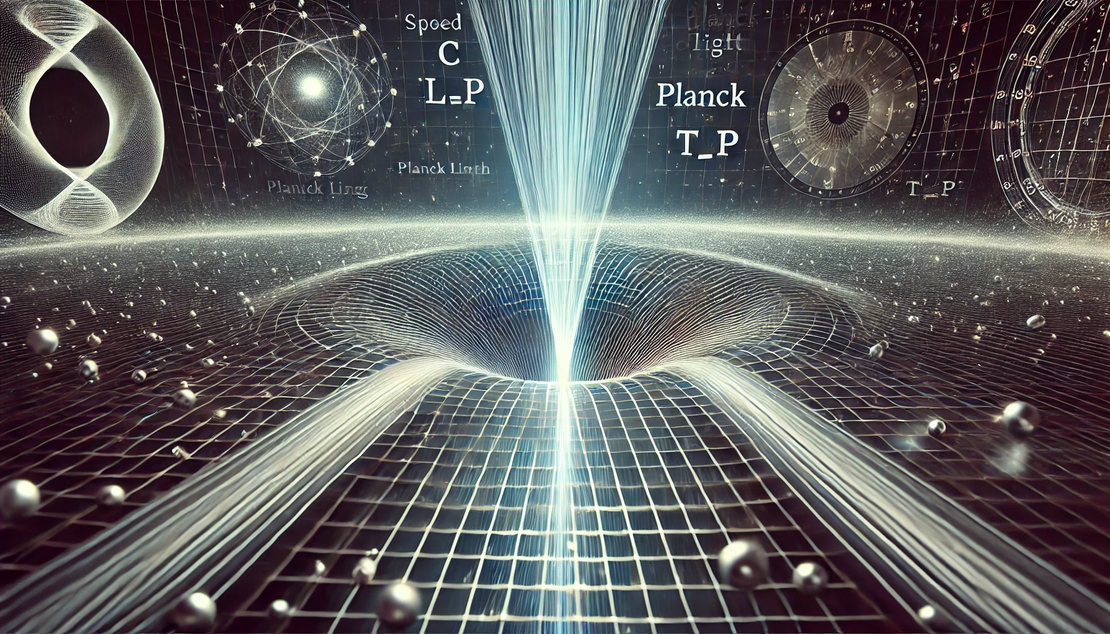The Fundamental Relationship Between the Speed of Light, Planck Length, and Planck Time
Max Planck, often referred to as the father of quantum mechanics, made groundbreaking contributions to physics in the early 20th century. In 1900, he introduced the concept of quantized energy levels while studying blackbody radiation, leading to the formulation of Planck’s constant (\(\hbar\)). This constant became a cornerstone of quantum mechanics, laying the foundation for the study of the smallest scales of nature and influencing our understanding of fundamental constants like the speed of light, Planck length, and Planck time.
Definitions
-
Speed of Light (\(c\))
The speed of light is the maximum speed at which all massless particles and information can travel in the universe. Its value is approximately \(299,792,458 , \text{m/s}\). -
Planck Length (\(l_p\))
The Planck length represents the smallest measurable length in quantum mechanics and gravitational theory. It is defined as:\[ l_p = \sqrt{\frac{\hbar G}{c^3}} \]
where:
- \(\hbar\) is the reduced Planck constant.
- \(G\) is the gravitational constant.
- \(c\) is the speed of light.
-
Planck Time (\(t_p\))
The Planck time is the time it takes for light to travel one Planck length in a vacuum. It is defined as:\[ t_p = \sqrt{\frac{\hbar G}{c^5}} \]
Relationship Between Them
The speed of light connects the Planck length and the Planck time through the elegant equation:
\[ c = \frac{l_p}{t_p} \]
This reflects that light traverses exactly one Planck length in one Planck time. The equation highlights the profound interplay between spatial (Planck length), temporal (Planck time), and universal constants.
Why Is \(c\) Constant?
The constancy of the speed of light, regardless of the observer’s motion, stems from its deep connection to the fundamental structure of spacetime and the Planck constants:
-
Lorentz Invariance
The principles of special relativity dictate that the speed of light remains the same for all observers, regardless of their relative motion. This invariance is baked into the equations of spacetime geometry. -
Ties to Planck Units
The Planck length and Planck time, which are derived from \(\hbar\), \(G\), and \(c\), represent the smallest measurable scales of space and time. Their definitions inherently involve the speed of light, making \(c\) a cornerstone of both quantum mechanics and relativity. -
Universal Nature of \(c\)
The Planck units are built from constants that are universal and do not depend on any particular observer. As a result, \(c\), which links these units, also remains invariant.
Thus, the constancy of \(c\) is not merely an empirical observation but a reflection of the fundamental symmetries of the universe.
Key Points
- The Planck length is derived from the constants \(\hbar\), \(G\), and \(c\), representing a fundamental unit in the domain of quantum gravity.
- The Planck time, similarly constructed, sets the lower limit for measurable time intervals.
- The speed of light serves as the unifying constant, bridging spatial and temporal scales in these fundamental units.
Conclusion
The relationship between the speed of light, Planck length, and Planck time reveals a deeply interwoven framework within the physical universe. By connecting the realms of quantum mechanics, relativity, and gravity, these constants illuminate the fundamental nature of space, time, and the limits of measurement. The constancy of \(c\), rooted in the very fabric of spacetime, serves as a testament to the elegant symmetries of nature and the pioneering work of physicists like Max Planck.
